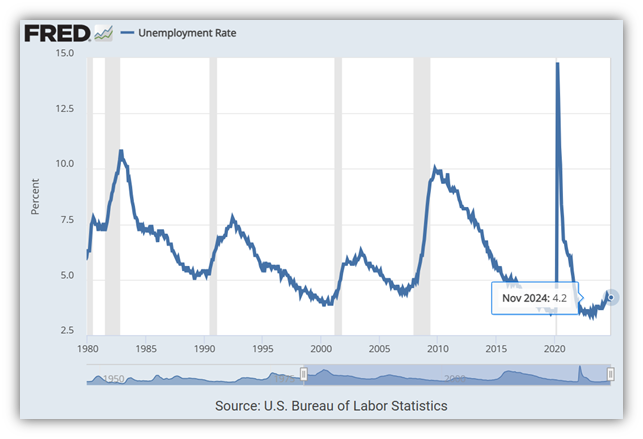Stocks are lower this week thanks in large part to a little surprise from the Fed. As expected, the Fed announced a 0.25% rate cut on Wednesday. But the surprise was not what they did, but what they said. Prior to this week’s meeting, the Fed and the markets were anticipating 4 rate cuts in 2025, ultimately lowering the Fed rate to 3.5% at year-end. However, the Fed is now forecasting just 2 rate cuts next year, leaving the Fed rate at 4.0% next year-end. This would mean less stimulus for the economy next year as borrowing costs would be higher and the markets are quickly making their adjustments. The Dow is now down almost 6% from it’s all-time high reached on December 4th, just a couple of weeks ago.
But the question we’ve been asking this year is, does the economy really need stimulus? According to the Atlanta Fed, we’re on track for 3.2% GDP growth this quarter, hardly a weak number. The Fed had previously mentioned that all those rate cuts were meant to protect the labor market and keep unemployment from rising. But with unemployment at a very low level of 4.2%, does this really make sense?

I believe the 4 rate cuts next year were also about the cost of refinancing the federal government’s debt. Of the approximately $7 trillion of spending in the US federal budget, $1 trillion is now going to interest payments alone. And as interest rates stay higher, that cost increases more quickly, digging us into an even deeper hole of debt.
Previously, the Fed was comfortable that inflation was heading in the right direction and could handle the stimulative effects of all those rate cuts next year. However, the election of Donald Trump has caused the Fed to consider the potential impacts of many of his professed policies on inflation. While the market has applauded his pro-growth policies, the Fed realizes many of his policies could result in potentially higher inflation. As such, they’ve decided a more cautious plan of 2 rate cuts next year is warranted until they can see what the next Trump administration will bring.
Have a great weekend.
Jack C. Harmon II, CFP®, CIMA
Principal, Harmon Financial Advisors
Registered Principal, Raymond James Financial Services
Harmon Financial Advisors, Inc. is an independent, fee-based financial planning firm and an independent Registered Investment Advisor. Investment advisory services offered through Raymond James Financial Services Advisors, Inc. and Harmon Financial Advisors, Inc. Securities offered through Raymond James Financial Services, Inc. Member FINRA/SIPC. Harmon Financial Advisors, Inc. is not a registered broker/dealer and is independent of Raymond James Financial Services, Inc.
The information contained in this report does not purport to be a complete description of the securities, markets, or developments referred to in this material. The information in this commercial email has been obtained from sources considered to be reliable, but we do not guarantee that the foregoing material is accurate or complete. Any information is not a complete summary or statement of all available data necessary for making an investment decision and does not constitute a recommendation. Any opinions are those of Harmon Financial Advisors, Inc. and not necessarily those of RJFS or Raymond James.
Investing involves risk and you may incur a profit or loss regardless of strategy selected.
The Dow Jones Industrial Average (DJIA), commonly known as “The Dow” is an index representing 30 stocks of companies maintained and reviewed by the editors of the Wall Street Journal.
Certified Financial Planner Board of Standards Inc. owns the certification marks CFP®, CERTIFIED FINANCIAL PLANNER™, and CFP® in the U.S., which it awards to individuals who successfully complete CFP Board’s initial and ongoing certification requirements.
Investments & Wealth Institute™ (The Institute) is the owner of the certification marks “CIMA” and “Certified Investment Management Analyst.” Use of CIMA and/or Certified Investment Management Analyst signifies that the user has successfully completed The Institute’s initial and ongoing credentialing requirements for investment management professionals.



